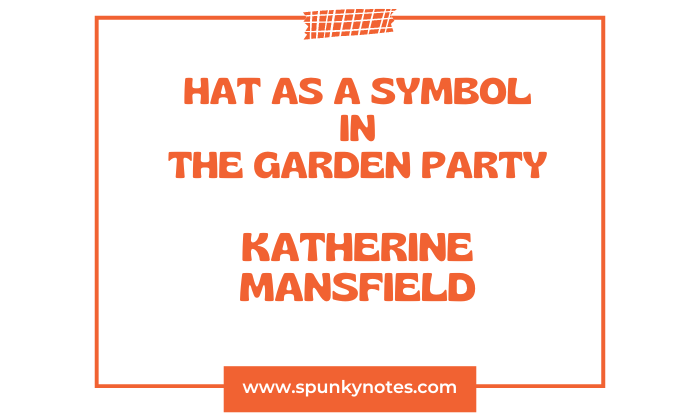

Estimated Reading Time: 5 min
Q. How does Katherine Mansfield use the hat as a symbol in “The Garden Party”?
Introduction
Katherine Mansfield, known for her use of symbolism, demonstrates this skill in her short story “The Garden Party.” The story uses symbols to highlight themes and show character development.
One important symbol in the story is the hat given to Laura Sheridan. It helps us understand Mansfield’s ideas about class differences, materialism, vanity, and personal change.
At first, the hat represents luxury and the comfortable life of the upper class. Laura enjoys the hat’s beauty and charm, which reflect her family’s wealth and status.
However, as the story progresses and Laura encounters the harsh realities of life outside her privileged bubble, the hat’s meaning changes. It becomes a reminder of the social divide and her privileged position.
Class Distinction
In Katherine Mansfield’s “The Garden Party,” the hat Mrs. Sheridan gives Laura is a strong symbol of class distinction. It shows the wealthy lifestyle of the Sheridans, reflecting their social privilege and wealth.
When Laura first puts on the hat, she enjoys its luxurious charm. It becomes a mark of her wealthy class and a symbol of the comfort and luxury she has grown up with. This symbol becomes stronger when Laura goes to the lane of the workers, where a man has died.
In contrast to the rich world Laura comes from, she now finds herself among sad, poor workers, and the hat seems out of place, almost mocking their hardship.
This makes the hat, once a source of joy, an uncomfortable reminder of her privilege. Laura’s discomfort with the hat in the workers’ lane makes the economic divide even more evident.
Therefore, the hat symbolizes the class divide and highlights Laura’s privileged life in stark contrast to the workers’ reality.
Materialism and Vanity
The hat shows the materialism and vanity in the Sheridans’ upper-class life. Laura’s interest in the hat shows their focus on buying goods and appearances.
Laura is drawn to the hat’s charm, reflecting her family’s love for material things. However, her interest fades as she faces the harsh realities outside her wealthy life.
The hat, once desirable, now symbolizes the emptiness of their vanity. Laura’s changing view of the hat criticizes her family’s materialistic lifestyle.
Distraction and Manipulation
Mrs. Sheridan cleverly uses the hat as a tool of distraction and manipulation. When Laura expresses her worries about holding a garden party after a worker’s death, her mother distracts her with the hat.
With its charm and beauty, this elegant accessory takes Laura’s attention away from the sad reality of the situation. It shows how material possessions can be used to change emotions and perspectives.
Mansfield uses this event to criticize the power of materialism, showing how it can cloud judgment and morality. In this case, the hat is a potent symbol of distraction, pulling Laura away from her moral concerns and back into the world of appearances.
Loss of Innocence
The hat symbolizes Laura’s journey from innocence to a deeper awareness of life’s realities. At the start, Laura’s fascination with the hat and excitement over the garden party show her innocent and sheltered upbringing.
However, seeing the harsh reality of the worker’s death is a turning point. Her fascination with the hat turns into discomfort, marking the loss of her innocence. Once a charming accessory, the hat seems an inappropriate symbol of luxury among the workers’ sorrow.
Mansfield uses the hat as a powerful symbol of Laura’s change, marking her entry into a world marked by the harsh realities of life.
Transformation and Awareness
The hat in Katherine Mansfield’s “The Garden Party” symbolizes Laura’s change and growing awareness of social inequalities. When Laura first receives the hat from her mother, it represents the luxury and comfort of her life within the Sheridan family.
It represents the world she knows – a world of wealth, privilege, and fancy garden parties. However, her view of the hat changes significantly as she steps into the workers’ lane.
In the poor surroundings of the workers’ homes, the hat’s symbolic meaning changes, highlighting Laura’s transformation. The once admired and loved hat symbolizes class, and luxury now feels out of place.
It is as if the hat, along with Laura, has been moved from a world of comfort into a place where such luxury is out of place and even, to some degree, disrespectful. The hat becomes a potent reminder of her privilege in the harsh light of the workers’ existence.
Katherine Mansfield in The Garden Party shows Laura’s internal change through her changing view of the hat,
She wished now she had put on a coat. How her frock shone! And the big hat with the velvet streamer – if only it was another hat!
The hat now symbolizes the economic differences that exist beyond her home’s lush garden. It makes her very aware of the gap between her world and that of the workers.
This change in perspective highlights her transformation from a naive, sheltered young girl to a more understanding and socially aware individual.
This change makes Laura more conscious of her society’s shortness of life and inequalities. She learns to feel for those less fortunate and realizes the triviality of her previous concerns, symbolized by the hat.
This change and awareness bring her closer to the harsh realities of life, making the hat a lasting symbol of her evolving consciousness.
In conclusion, Mansfield uses the hat as a powerful symbol in “The Garden Party,” showing Laura’s journey of self-realization, her awakening to class differences, and the superficiality of her privileged lifestyle.


